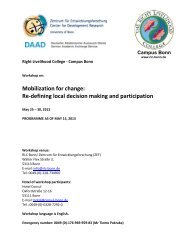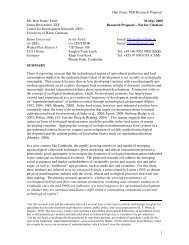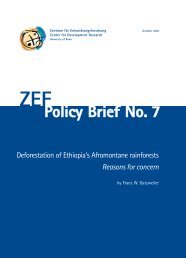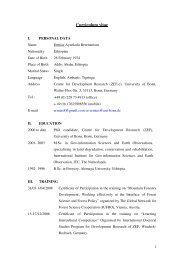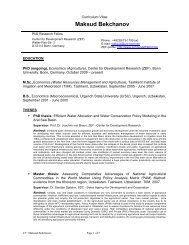Karuna Trust, Karnataka - ZEF
Karuna Trust, Karnataka - ZEF
Karuna Trust, Karnataka - ZEF
Create successful ePaper yourself
Turn your PDF publications into a flip-book with our unique Google optimized e-Paper software.
Good and Bad Practices in Microinsurance<strong>Karuna</strong> <strong>Trust</strong>, India- Insurance: The product was designed to be complementary, i.e., it does not coverservices provided by public providers; therefore, the cost is low for morecomprehensive protection, without having to establish a new infrastructure.• Lower barriers for seeking care: Compensation for wage loss is likely to influenceclients’ healthcare utilization positively—people are less likely to delay seeking care andtherefore might enjoy better health status.Lessons: Product Design• Market research is the starting point: Solid market research helps create productsdesired by the clients. The money for such an extensive study seems well invested,although it has to be acknowledged that for most microinsurance schemes, externalfinancial support might be necessary for this.• Complement existing offers: Making use of benefits offered elsewhere (e.g., by thepublic providers) helps to keep the premiums low while – at the end – offering aneffective risk management mechanism for the clients.• No risk taking, no innovation: To design an innovative product, some goodwill on theside of the risk bearing insurance company is necessary. NIC has agreed to give a riskyundertaking like compensation of wage loss a try despite some concerns.• Do not forget the indirect costs of illness: Not being able to work and even thetransportation to the health care provider constitute a high financial burden for poorhouseholds – sometimes as high as the direct costs of seeking care. <strong>Karuna</strong> <strong>Trust</strong> takesthis into account by compensating for loss of wages and providing emergencytransportation to the general hospital.• Generic drugs are cheaper: As long as <strong>Karuna</strong> <strong>Trust</strong> reimbursed clients for the drugspurchased, branded drugs were bought. <strong>Karuna</strong> succeeded to save some costs byproviding generic drugs in the health facilities themselves.• People care when they pay: As people start paying for their insurance, they take overownership and demand quality for their money.Lessons: Delivery Mechanisms• Strong links ensure good flow of information: <strong>Karuna</strong> <strong>Trust</strong> offers a good example ofan effective way of using established NGO-infrastructure to disseminate informationabout insurance and distribute the insurance product. In <strong>Karuna</strong>’s other activities wherehealth insurance is not offered, the level of knowledge about insurance among clientsseems to be significantly lower.• “Second best solutions” can improve over time: Although many clients might preferprivate health care providers, they accept using public ones. By compensating for some oftheir shortcomings (especially drugs), the insurance helps to increase acceptance of publicproviders.• Sometimes it is too far: When restricting a health insurance scheme to designatedfacilities, those who live further away are less likely to join.v



